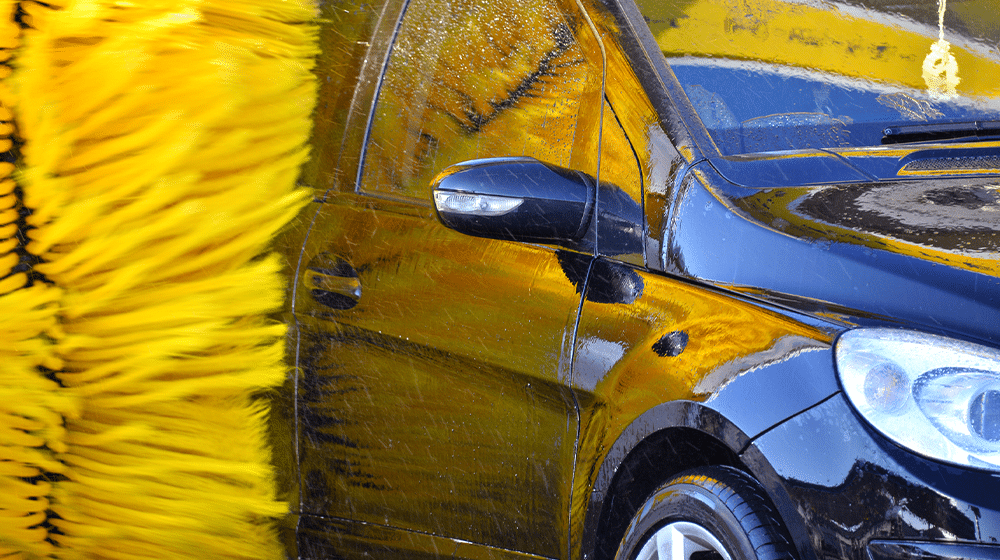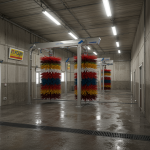Step right up and prepare to have your mind blown as we unravel the ultimate mystery: How much water does a delivery vehicle automatic wash really consume? If you’ve ever wondered about the environmental impact of keeping your fleet looking pristine, we have the answers you’ve been searching for.
At LazrTek, we understand the importance of being eco-conscious while still ensuring your vehicles are spotless. In this article, we dive deep into the world of delivery vehicle automatic washes to uncover the truth about water consumption.
Join us as we explore the ins and outs of this fascinating topic, revealing surprising facts and dispelling common misconceptions along the way. We’ve crunched the numbers, examined industry trends, and consulted experts to bring you an accurate and insightful analysis.
So, whether you’re a business owner looking to minimize your ecological footprint or simply curious about the inner workings of delivery vehicle washes, this article is a must-read. Get ready to be enlightened and make more informed choices for your fleet maintenance.
Environmental impact of automatic wash systems
Delivery vehicle automatic wash systems are undoubtedly convenient, but what about their impact on the environment? The excessive use of water is often cited as a major concern. However, it’s essential to delve deeper and understand the broader environmental implications.
While water consumption is a valid concern, it’s only one aspect of the equation. Automatic wash systems also utilize energy, produce wastewater, and can contribute to chemical pollution if not managed properly. Therefore, it’s crucial to consider the holistic impact of these systems.
One way to mitigate the environmental impact is by investing in eco-friendly automatic wash systems. These systems are designed to minimize water usage, energy consumption, and chemical runoff, providing a more sustainable solution for fleet maintenance. By opting for such systems, businesses can significantly reduce their ecological footprint without compromising on cleanliness.
Water usage in delivery vehicle automatic wash
Now, let’s dive into the heart of the matter: water consumption in delivery vehicle automatic washes. The amount of water used by these systems can vary significantly depending on various factors, including the design of the wash equipment, the size and type of vehicles being washed, and the specific settings chosen.
On average, a standard delivery vehicle automatic wash can use anywhere from 40 to 100 gallons of water per wash cycle. This may seem like a substantial amount, but it’s important to put it into perspective. Compared to manual washing methods, which can consume up to 150 gallons per vehicle, automatic washes are typically more efficient.
However, it’s worth noting that these figures are approximate and can vary depending on the specific system and its configuration. Additionally, some advanced automatic wash systems employ water-recycling technologies, further reducing water consumption and wastewater generation.
Factors that affect water consumption in automatic wash systems
To better understand the varying water consumption in automatic wash systems, let’s examine the key factors that influence these figures. By identifying and addressing these factors, businesses can optimize their wash processes and reduce water usage.
1. Wash Equipment Design: The design of the wash equipment plays a crucial role in determining water consumption. Modern systems often feature advanced nozzles and sprayers that optimize water flow and coverage, ensuring effective cleaning while minimizing waste.
2. Vehicle Size and Type: Larger vehicles naturally require more water to clean thoroughly. Delivery trucks, for example, have more surface area compared to compact cars. It’s essential to consider the specific requirements of your fleet when evaluating water consumption.
3. Wash Settings and Programs: Automatic wash systems offer various settings and programs, allowing users to customize the wash process. Some settings utilize more water for heavy-duty cleaning, while others are designed for light maintenance. Choosing the appropriate setting can help optimize water usage.
By considering these factors and implementing efficient wash strategies, businesses can significantly reduce water consumption, minimizing their environmental impact.
Comparing water usage of different automatic wash systems
Not all automatic wash systems are created equal when it comes to water usage. Some systems are engineered to be more water-efficient than others. Let’s explore some of the most common types of automatic wash systems and compare their water consumption.
1. Touchless Wash Systems: Touchless wash systems rely on high-pressure water jets and specialized detergents to clean vehicles without physical contact. These systems are known for their ability to conserve water since they do not require water-intensive brushes or cloths.
2. Brush Wash Systems: Brush wash systems, on the other hand, utilize rotating brushes or cloth strips to scrub the vehicle’s surface. While these systems can provide a more thorough clean, they tend to use more water due to the need for continuous rinsing.
3. Hybrid Wash Systems: Hybrid wash systems combine the best of both touchless and brush systems. They utilize high-pressure water jets for initial cleaning and then employ brushes or cloths for a more detailed scrubbing. These systems strike a balance between water efficiency and thorough cleaning.
When choosing an automatic wash system for your delivery vehicles, it’s essential to assess the water consumption of each option and select the one that aligns with your sustainability goals.
Strategies to reduce water consumption in delivery vehicle automatic wash
Minimizing water consumption in delivery vehicle automatic washes is not only beneficial for the environment but also for your bottom line. By implementing the following strategies, you can achieve both water savings and cost savings:
1. Water-Recycling Systems: Installing water-recycling systems enables the reuse of treated wastewater, significantly reducing the amount of freshwater required. These systems filter out contaminants and chemicals, ensuring the recycled water meets necessary hygiene standards.
2. Optimized Rinse Cycles: Adjusting rinse cycles to use the minimum amount of water necessary for effective cleaning can make a significant difference in water consumption. By fine-tuning the wash settings, businesses can strike a balance between cleanliness and water savings.
3. Regular Maintenance and Equipment Upgrades: Proper maintenance of wash equipment is essential to ensure optimal performance and water efficiency. Regularly inspecting and repairing leaks or malfunctions can prevent unnecessary water wastage. Additionally, upgrading to more water-efficient equipment can yield long-term benefits.
4. Employee Training and Awareness: Educating employees about the importance of water conservation and providing guidelines for efficient wash practices can go a long way. Encouraging responsible water usage and empowering employees to make environmentally conscious choices can contribute to significant water savings.
By implementing these strategies, businesses can take meaningful steps towards reducing water consumption in their delivery vehicle automatic wash processes, benefiting both the environment and their operations.
Case studies of companies implementing water-saving measures in their automatic wash systems
Real-world examples of companies successfully implementing water-saving measures in their automatic wash systems can provide valuable insights and inspiration for others. Let’s explore a couple of case studies showcasing effective water-saving strategies:
1. Company A: Company A, a large logistics firm, implemented a water-recycling system in their automatic wash facility. By treating and reusing wastewater, they were able to reduce freshwater consumption by 50%. This not only helped them minimize their environmental impact but also resulted in significant cost savings.
2. Company B: Company B, a local delivery service, focused on optimizing their wash settings and training their employees to be mindful of water usage. By fine-tuning their rinse cycles and raising awareness about water conservation, they achieved a 30% reduction in water consumption without compromising cleanliness.
These case studies demonstrate that with the right strategies and commitment, businesses can make a substantial difference in their water consumption, leading the way towards more sustainable fleet maintenance practices.
Cost implications of water usage in automatic wash systems
Apart from the environmental impact, water usage in automatic wash systems also has financial implications. The cost of water, particularly in areas with high water rates or scarcity, can significantly impact a business’s operational expenses.
By reducing water consumption, businesses can experience substantial cost savings in the long run. Additionally, implementing water-saving measures can enhance a company’s reputation as an environmentally responsible organization, potentially attracting eco-conscious customers and partners.
When evaluating the cost of water usage in automatic wash systems, it’s essential to consider the broader financial benefits that come with reduced consumption and increased sustainability.
The future of water-saving technologies in delivery vehicle automatic wash
As the world becomes increasingly focused on sustainability, the future of water-saving technologies in delivery vehicle automatic washes looks promising. Innovations in equipment design, water-recycling systems, and wash processes continue to emerge, offering more efficient and eco-friendly solutions.
Advanced sensors and artificial intelligence are being integrated into automatic wash systems, allowing for precise water control and optimizing cleaning efficiency. Additionally, ongoing research and development are exploring alternative cleaning agents that are less harmful to the environment, further reducing the ecological impact of wash processes.
The future of delivery vehicle automatic washes lies in harnessing technology and innovation to strike the perfect balance between cleanliness, water efficiency, and environmental responsibility.
Conclusion
Unveiling the mystery of water consumption in delivery vehicle automatic washes has revealed a complex landscape. While these systems do consume water, they also offer opportunities for businesses to minimize their environmental impact and make more sustainable choices.
By considering factors that affect water consumption, comparing different automatic wash systems, and implementing water-saving strategies, businesses can significantly reduce their ecological footprint without compromising cleanliness. The cost implications and future advancements in water-saving technologies further reinforce the importance of making conscious choices for fleet maintenance.
So, the next time you send your delivery vehicles through an automatic wash, remember that there’s more to it than meets the eye. Behind the gleaming exterior lies a world of innovation, environmental responsibility, and a commitment to a cleaner future.




